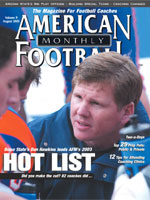AMERICAN FOOTBALL MONTHLY THE #1 RESOURCE FOR FOOTBALL COACHES
Article CategoriesAFM Magazine
|
Maximizing Player PerformanceTwo-A-Days: Tackle the Heatby: AFM Editorial Staff © More from this issue Every year in the month of August thousands of coaches from around the country prepare their players for yet another season of football. And every year thousands of football players are at risk of succumbing to the threat of heat illness linked to dehydration. In recent years several athletes from high school to the professional ranks have died from heat stroke, causing many to take a closer look at the importance of proper cooling and hydration techniques for preventing heat illness in football. This year, the NCAA enacted a new law regulating the use and frequency of two-a-day practices. Teams may no longer hold consecutive two-a-day practices, thus reducing the threat of overexertion and heat illness during the hottest month of the year. However, high schools are not governed by the NCA....The full article can only be seen by subscribers. Subscribe today!
|
|
|||||||
| HOME |
MAGAZINE |
SUBSCRIBE | ONLINE COLUMNISTS | COACHING VIDEOS |
Copyright 2025, AmericanFootballMonthly.com
All Rights Reserved





